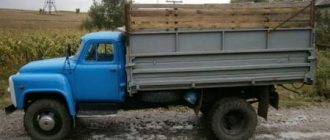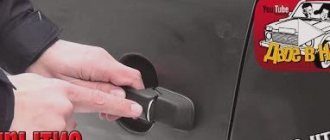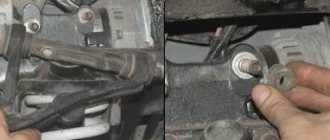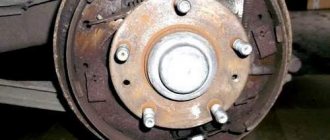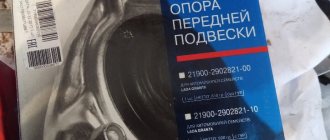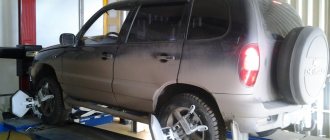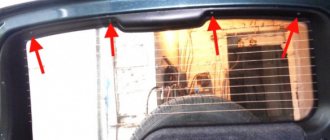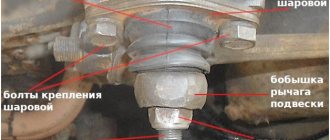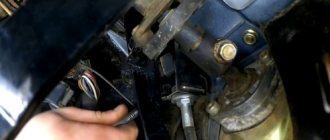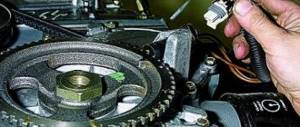Removing the side link
We hang and remove the wheel.
To remove the right side rod, turn the steering wheel all the way to the left.
Use pliers to remove the cotter pin
Using a 22mm wrench, unscrew the nut securing the side link to the steering knuckle lever.
Use a puller to press the ball pin out of the lever.
A fork puller can be used.
If there is no puller, unscrew the nut not completely, insert the mounting blade into the spacer between the side rod and the steering knuckle lever and hit the end of the lever with a hammer.
The ball pin can also be pressed out of the lever by striking a sharp blow from below with the back of a hammer on the steering knuckle lever near the hinge
We remove the ball pin from the eye of the steering knuckle lever.
Use a puller to press the ball pin out of the pendulum arm.
The finger can also be pressed out by striking a sharp blow from below with a hammer through a chisel with a blunt end on the pendulum lever.
We take out the right side rod.
Similarly, remove the left side rod.
We install the side link so that a long tip is attached to the steering knuckle lever.
After replacing the rod, we check the wheel alignment (see Angles of the front wheels)
Replacement
To replace, we will need new steering rods for the Chevrolet Niva and a set of tools; after everything is ready, we can proceed to replacement:
- Installing the car in the pit
- We remove the wheel from the side where the replacement will be made.
- Remove the pin pin from the outer hinge
- We take a special puller and remove the hinge pin from the steering knuckle. If there is no puller, you can use a hammer to apply small blows to the end of the lever
- Remove the cotter pin from the inner hinge nut, then unscrew the nut
- We press out the ball joint pin, this can be done using the same puller or a hammer
- Removing the steering rod
- Install the new part in reverse order
Replacing the middle link
- We press out the pin of the side rods and move the entire structure to the side
- Unscrew the four nuts and disconnect the gearbox stabilizer
- We remove the cotter pin of the ball joint and the fastening nut and unscrew the fasteners
- Pressing out the tip
- Removing the rods
- Replace with new ones
Removing the middle link
We carry out the work on an inspection ditch or a lift.
Use pliers to remove the cotter pin
Using a 22mm wrench, unscrew the nut securing the middle link to the pendulum arm.
Using a fork puller, press the middle link ball pin out of the hole in the pendulum arm.
The pin can also be pressed out by applying a sharp blow from below (near the hinge) with a chisel with a blunt end to the pendulum arm.
Remove the ball pin from the eye of the pendulum arm.
Similarly, we press the ball pin out of the bipod.
Remove the middle link.
Install the middle link in the reverse order.
The left hinge pin (inserted into the bipod hole), in addition to rotation, can swing (unlike the right one).
In this case, when installing the rod on the car, we orient it so that its longitudinal axis is in front of the hinge axes
Chevrolet car repair manuals and tips
How to repair the power steering of a Chevrolet Niva
Today, it is perhaps difficult to imagine a car that does not have hydraulic power steering. If such cars are found, they are considered transport of the last century. Thanks to the presence of power steering on a Chevrolet Niva, wheelbase control becomes very simple, and most importantly, easy.
The Chevrolet Niva comes from a family of SUVs, which necessitates such a function. After all, it is very difficult to drive a car that weighs more than 1.5 tons, and the road leaves much to be desired. And on highways or highways it is very difficult to imagine driving a Chevrolet Niva at high speed without power steering.
But often there are malfunctions in the operation of the power steering, which must be corrected immediately, otherwise there is a risk of the steering wheel jamming. In such cases, you can use the services of a car service, but the cost of repairs or replacement of components will cost a pretty penny. Therefore, the best option would be to carry out repairs in your garage with your own hands.
What is power steering
And also interesting: a Chevrolet Niva and a standard key fob. VAZ forum
This is a device that allows you to control the wheels of a car using the steering wheel without much physical effort. Anyone who has never driven a car without power steering will find it very difficult to imagine the importance of this function. The amplifier is especially indispensable in heavyweight cars, which include the Chevrolet Niva.
1. Pump; 2. Tank; 3. Valve system; 4. Manual hydraulic rack.
A more clear location of these components in the car is shown in the photo below.
power steering diagram
Power steering pump. The pump is the main element in performing the function of power steering. It is a device filled with an oil mixture. The drive operates from the car engine. The pump is driven by a belt drive. Inside, the pump consists of a special chamber, shaft and blades.
There are also two holes, one of which is the entrance, and the second is the exit. At the inlet the pressure is always equal to atmospheric pressure, and at the outlet it is much higher, about two atmospheres. When the engine is running, the pump is automatically activated, it pumps liquid to a certain pressure and maintains the pressure.
Power steering pump diagram
Important! It is necessary to periodically monitor the fluid level, which can lead to failure of the power steering pump.
Power steering fluid reservoir
Rotary valve. This device performs an auxiliary function. When the steering wheel is rotated by the driver, the rotary valve contributes to the steering power, and when there is no such need, for example, when driving in a straight line, it has no effect on the wheel alignment.
Rotary valve operation diagram
Steering rack. The design is a conventional mechanical rack, to which hydraulic lines are connected. These lines are the driving force involved when changing the wheel alignment angle. Schematically, the rail represents the structure shown in the photo below.
Steering rack diagram
Power steering pump repair
1. Remove the power steering drive belt, sump protection and engine compartment mudguards. 2. All liquid is pumped out from the tank. 3. Use a screwdriver to lock the pulley and loosen the fastening of the bolts to the flange. 4. The fastening bolts are completely unscrewed and the pulley is removed. 5. Drain the remaining liquid from the device into a special jar. 6.
The hose clamp is loosened and the hose itself is removed. 7. The bolt fitting is unscrewed and removed. 8. The hose tip must be sealed with special washers. 9. Unscrew the fasteners. 10.The bolt that connects the pump to the oil filter is also unscrewed. 11.The upper mounting bolt is unscrewed and the power steering pump itself is removed.
1. Disassembling the pump. 2. Fault assessment. 3. Repair. 4. Assembling the device or replacing it.
power steering pump removed from car
The photo shows an assembled pump from a Chevrolet Niva car. Getting to the first point, it is worth noting that repairing the power steering device is feasible only in 40% of cases, all others simply require replacement with a new one.
Disassembling the device: 1) Unscrew all fastening screws on the cover. 2) The inside of the device is removed. 3) After removing the internal parts, you need to remember their order of arrangement and fastening.
1. It is necessary to clean the internal parts to find the cause of the malfunction. Disassembled power steering pump 2. If, when removing the cover, wear of the internal parts or their defects is detected, then you need to purchase new parts or try to remove the defects. If the defects are severe, then repair will no longer help.
The photo shows wear on the pump race, which cannot be repaired. 3. The cause of the malfunction may also be wear of the bearing or oil seal. 4. The shaft has sharp edges, which wear out over time, enlarge and burrs appear. They need to be removed. 5. The cylinder is taken and examined. Its surface should be smooth and without chips or burrs. In this case, they need to be eliminated.
So, knowing the faults, you can proceed directly to eliminating them and carrying out repairs.
1) Rags; 2) Solvent; 3) Sandpaper with maximum grit P2000. 4) Triangular file. 5) Drill with a diameter of 12 mm. 6) Drill or screwdriver.
Cylinder. So, first we will try to remove defects on the inside of the cylinder. To do this, we make a homemade sanding wheel. Take sandpaper with a grit of P2000 and wrap it around the drill in two or three turns. To keep it stationary, we attach a sandpaper with a drill at the base of the drill, as shown in the photo below.
Sanding attachment
Next, we fix the cylinder vertically in a vice and begin sanding the entire inner surface of the cylinder with sandpaper.
Important! Severe irregularities cannot be eliminated this way, so it is better to buy a new cylinder. If the defects are minor, but they are noticeable, then they are ground off within a few minutes. After sanding, wipe the surface with solvent to remove small particles. It is very important!
Bearing repair. If there are defects in the bearing or oil seal, they must be removed and replaced with new ones. The bearing and seals cannot be repaired.
Shaft repair includes turning the grooves until they are completely smooth. To do this, we will use sandpaper type P1000. We fold it in half and insert the corner end into each groove. It is necessary to grind off all the irregularities and burrs in the groove. You can use a triangular file or rasp, put sandpaper on it and also grind all the corners, as shown in the photo below.
Removing burr gur
Also interesting: Niva VAZ 21213 engine: characteristics, malfunctions and tuning
If the internal parts of the device were not severely damaged and the repair helped eliminate them, then we proceed to the final stage - assembling the power steering pump. If it cannot be repaired, then it is better to purchase a new one.
Assembling the pump and installing it in place is carried out in the reverse order of removing the parts and the device itself.
Important! After repairing the power steering pump, unnecessary sounds may appear, especially with significant rotations of the steering wheel. Don’t be alarmed, this is a normal phenomenon - the repaired parts rub into new places. After 10-20 km, this sound will disappear.
1. when turning the steering wheel in different directions, force is required, as if there was no power steering; 2. extraneous noise or hum in the pump; 3. periodic failures in the operation of the hydraulic booster.
Therefore, pay attention to such important factors and promptly repair or replace faulty parts. Happy renovation work!
Replacing mud caps and tie rod ends
Mud caps and tie rod ends can be replaced on the vehicle. For clarity, these operations are performed with the traction removed.
To replace the dirt cap, knock it out with a soft metal drift.
We clean the ball joint from old grease and dirt.
If traces of corrosion are found on the ball pin and free movement of the pin in the body is felt, replace the ball joint with the rod end.
We press the new dirt cap onto the hinge body with a suitable piece of pipe, resting on the metal ring of the cap.
Purpose of steering rod on Chevrolet Niva
A tie rod is a steering part that transmits force from the steering wheel to the steering knuckles, which ultimately causes the wheels to rotate. The rod is a steel tube, at the ends of which there is a threaded connection and a steering tip. The threaded design ensures the connection between the short and long tips. The tips are also called hinges. They are designed to allow free movement of moving parts in the steering structure.
Faulty steering rods of the Niva Chevrolet
The steering mechanism is a rather capricious design that requires diagnosis every year, especially for a car like the Chevrolet Niva. After all, as you know, Shniva is designed to overcome particularly harsh road and off-road surfaces.
The first sign of a faulty steering mechanism is increased play. This may indicate a malfunction of the steering rods due to extreme wear of the hinges. In this case, there are two ways to correct the situation:
- Carry out restoration of steering rods, replacing worn mechanisms (hinges).
- Replace the entire mechanism.
What is power steering and what does it consist of?
Thanks to this device, steering the wheels of a car becomes easier, while no great physical effort is required from you; those who have not dealt with cars without it do not really understand the importance of this device. The system of this element includes:
- Tank
- Pump
- Manual hydraulic rack
- Valve system
Let's look at these system details in more detail.
- The first element is a plastic tank; it contains the liquid that is used in the gur system; it can be either synthetic or mineral. Therefore, its content level should be checked.
- The power steering pump is the main element that performs the function of power steering, which is filled with an oil mixture; it runs from the car engine itself. It is activated by a temporary transmission. It consists of a chamber, blades and shaft, inlet and outlet. While the engine is running, liquid is pumped into it, forming a certain pressure; if there is an excess of it, the check valve will operate, which is responsible for how much of this liquid should be in the system.
- Rotary valve is responsible for auxiliary functions. It helps when turning the steering wheel, and when there is no such need, it is in a calm state, without affecting the wheel angle settings.
- The steering rack is a regular mechanical rack to which hydraulic lines are connected, which act as a driving force that is felt when the wheel alignment angle changes.
This is a device that allows you to control the wheels of a car using the steering wheel without much physical effort. Anyone who has never driven a car without power steering will find it very difficult to imagine the importance of this function. The amplifier is especially indispensable in heavyweight cars, which include the Chevrolet Niva.
An important function in a car is performed using such components as:
- Pump;
- Tank;
- Valve system;
- Manual hydraulic rack.
A more clear location of these components in the car is shown in the photo below.
Let's briefly look at all the elements of the power steering system. It is necessary to know the functions and design of these parts in order to be able to carry out various repairs.
Power steering pump. The pump is the main element in performing the function of power steering. It is a device filled with an oil mixture. The drive operates from the car engine. The pump is driven by a belt drive. Inside, the pump consists of a special chamber, shaft and blades.
There are also two holes, one of which is the entrance, and the second is the exit. At the inlet the pressure is always equal to atmospheric pressure, and at the outlet it is much higher, about two atmospheres. When the engine is running, the pump is automatically activated, it pumps liquid to a certain pressure and maintains the pressure.
Also interesting: The battery indicator came on
It is this element that is the main reason for the non-functioning of the power steering system.
Power steering reservoir. It is a plastic tank in which the fluid used in the power steering system is stored. The fluid can be either mineral oil or synthetic. On the Niva Chevrolet, the tank is located under the hood on the driver's side.
The photo shows a tank that is used in cars
Rotary valve. This device performs an auxiliary function. When the steering wheel is rotated by the driver, the rotary valve contributes to the steering power, and when there is no such need, for example, when driving in a straight line, it has no effect on the wheel alignment.
Conventional design of a rotary valve
The operating principle is based on a pressure shift in one of the outputs to the steering rack. So, for example, when the steering wheel is rotated to the right, the rack piston moves under pressure and thereby changes the angle of rotation of the wheels, which, in fact, reduces the need for strong physical effort.
Steering rack. The design is a conventional mechanical rack, to which hydraulic lines are connected. These lines are the driving force involved when changing the wheel alignment angle. Schematically, the rail represents the structure shown in the photo below.

